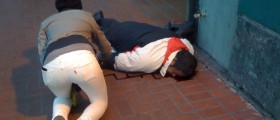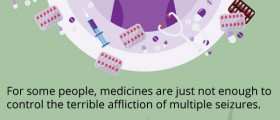
Epilepsy is a serious neurological disorder characterized by involuntary contractions of muscles due to abnormal behavior of electrical signals in the brain. The condition can be mild and well-tolerated and quite responsive to standard treatment. However, epilepsy is sometimes severe, interferes with everyday activities when symptoms cannot be brought under control with the available medications.
The disorder can be classified according to the type of seizures patients experience. The basic classification of seizures includes two types, partial and generalized seizures. Unlike partial seizures that affect only small parts of the brain, generalized form of the disease develops due to the spread of the abnormal electrical signals to wide portions of the brain.
Seizures in Epilepsy
Seizure are the main signs of epilepsy. Except from the basic classification, scientist have divided seizures into 40 different types which are generally defined according to the affected brain area. Even though sometimes there are several types of seizures a person is suffering from, the disease mostly follows one pattern and a consistent set of symptoms.
Generalized seizures are more complex and cause greater damage to the person compared to partial (focal) seizures. The attack of generalized seizures is almost always accompanied by complete loss of consciousness which is regain afterwards. This type of seizures has its own subtypes, so there are absences, myoclonic jerks, clonic seizures, atonic seizures, tonic seizures and tonic-clonic seizures.
Absence seizures are specific because they cause no typical muscle contractions. They are frequently reported among children who during the attack lose awareness of their surrounding for approximately 20 seconds. The person may stare without additional response or there are eye flutters. One may also smack his/her lips. There is no memory of the attack and as soon it is over the affected individual continues doing what he/she started prior to the attack. Absence seizures may repeat and interfere with the child's performance at school.
The next subtype are myoclonic jerks. These cause twitching of certain body parts, mostly the upper or lower extremities. The affected body part looks as if it has received an electric shock. There is no loss of consciousness. Myoclonic jerks usually occur soon after waking up, may be isolated or occur in a combination with other subtypes of generalized seizures.
Furthermore, we have clonic seizures. They are similar to myoclonic jerks but generally last much longer and may be accompanied by loss of consciousness.
Atonic seizures are specific because there is no contraction of the affected muscles. Instead they relax so a person might suddenly fall and hurt him/herself. Most individuals suffering from atonic seizures are prone to facial injuries.
On the other hand, when one is dealing with tonic seizures, another type of generalized seizures, his/her muscles become stiff and also interfere with the balance, causing falls. In this case injuries usually affect the back of the head.
And finally, there are tonic-clonic seizures. As their name suggests these seizures represent a combination of tonic and clonic seizures. Patient's body becomes stiff and there is additional muscle twitching. The attack goes through two stages. There is loss of consciousness and most patents lose the control over their bladder and wet themselves. Even though in the majority of cases tonic-clonic seizures last between 1 and 3 minutes, they may linger and sometimes even progress into status epileptic, a medical emergency and life-threatening neurologic disorder when seizures cannot be easily brought under control and may cause severe damage to the brain. It is estimated that around 60% of all patients suffering from epilepsy actually experience tonic-clonic seizures.
In the end, auras are one of potential characteristics of generalized seizures. Namely, patients may get a distinctive feeling or experience warning signs of the forthcoming attack.
What are Focal Seizures?
Focal or partial seizures are a type of seizures characterized by abnormal electrical activity that remains in a limited area of the brain.
Similarly to generalized seizures focal seizures are additionally classified into a couple of subtypes. During simple partial seizures patients remain conscious throughout the entire attack while when complex partial seizures occur, they usually lose their sense of awareness and simple cannot remember the attack.
Most patients with simple partial seizures experience changes in the appearance of the observed objects. They additionally experience changes in taste, smell or sometimes sound. One more characteristic of simple partial seizures is déjà vu, the feeling that one has already witnessed/experienced the current situation. Additional symptoms include a tingling sensation, a sudden intense emotion, stiffness of muscle of the extremities or the face and twitching affecting one side of the body.
Complex partial seizures, on the other hand, cause lips smacking, hand rubbing, making random noises and uncontrollable moving the arms around. Furthermore, patients may pick at clothes or fiddle with object during the attack. Abnormal posture and repeated chewing/swallowing although there is no food in the mouth are two more characteristics of complex partial seizures.
And finally, according to certain data complex partial seizures affect 2 out of 10 individuals suffering from epilepsy.

















Your thoughts on this
Loading...